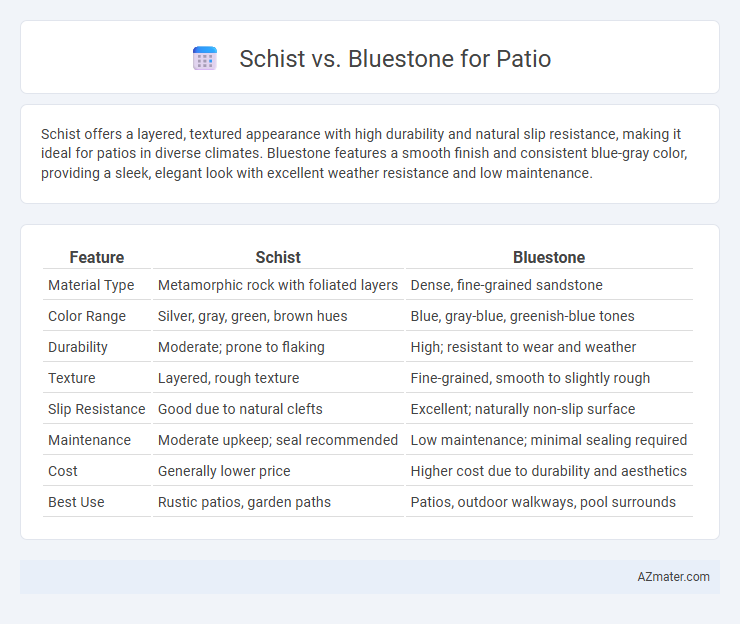Schist offers a layered, textured appearance with high durability and natural slip resistance, making it ideal for patios in diverse climates. Bluestone features a smooth finish and consistent blue-gray color, providing a sleek, elegant look with excellent weather resistance and low maintenance.
Table of Comparison
| Feature | Schist | Bluestone |
|---|---|---|
| Material Type | Metamorphic rock with foliated layers | Dense, fine-grained sandstone |
| Color Range | Silver, gray, green, brown hues | Blue, gray-blue, greenish-blue tones |
| Durability | Moderate; prone to flaking | High; resistant to wear and weather |
| Texture | Layered, rough texture | Fine-grained, smooth to slightly rough |
| Slip Resistance | Good due to natural clefts | Excellent; naturally non-slip surface |
| Maintenance | Moderate upkeep; seal recommended | Low maintenance; minimal sealing required |
| Cost | Generally lower price | Higher cost due to durability and aesthetics |
| Best Use | Rustic patios, garden paths | Patios, outdoor walkways, pool surrounds |
Introduction to Schist and Bluestone Patios
Schist patios feature natural stone with a distinctive flaky texture and layered appearance, offering a rugged yet elegant outdoor surface that enhances garden aesthetics. Bluestone patios utilize dense, fine-grained sandstone known for its smooth finish, durability, and cool blue-gray hues, creating a sleek and contemporary look. Both materials provide durable and stylish options for patio surfaces, with choices influenced by desired texture, color palette, and regional availability.
Geological Origins and Composition
Schist is a metamorphic rock formed from shale or mudstone subjected to intense heat and pressure, resulting in its characteristic foliated texture composed primarily of mica minerals and quartz. Bluestone, often a type of sandstone or limestone, originates from sedimentary rock formed by the compaction and cementation of sand-sized mineral particles, rich in feldspar and quartz. These distinct geological origins influence their durability, texture, and appearance, with schist offering a layered, crystalline surface and bluestone providing a smoother, often denser composition ideal for patios.
Aesthetic Differences: Color and Texture
Schist patios showcase a rich, layered texture with sparkling mineral flecks that create a dynamic, natural appearance, often featuring earth tones like gray, green, and brown. Bluestone offers a smoother, more uniform surface with subtle grain patterns and cooler shades of blue, gray, and sometimes hints of purple, lending a sleek and modern look. The choice between schist and bluestone significantly impacts the patio's visual appeal, with schist emphasizing rustic, textured elegance and bluestone providing a refined, understated aesthetic.
Durability and Longevity Comparison
Schist offers exceptional durability due to its foliated structure, making it resistant to cracking and weathering, ideal for long-lasting patio surfaces. Bluestone is known for its dense composition and impressive hardness, providing excellent wear resistance and a lifespan that can exceed several decades with proper maintenance. Both materials withstand heavy foot traffic and harsh elements, but bluestone generally requires less upkeep to maintain its integrity over time.
Slip Resistance and Safety Features
Schist offers excellent slip resistance due to its naturally rough, textured surface, making it a safe choice for patios in wet conditions. Bluestone, while visually appealing with its smooth, fine-grained finish, typically requires additional treatments or texturing to enhance traction and prevent slips. Prioritizing slip-resistant properties, schist provides superior safety for outdoor spaces prone to moisture and foot traffic.
Installation Process and Techniques
Schist and bluestone differ significantly in their installation process due to varying hardness and texture; schist requires careful cutting and sealing to prevent flaking, while bluestone's denser composition allows cleaner, more precise cuts. Proper sub-base preparation and leveling are crucial for both, with schist needing extra attention to avoid uneven settling because of its layered structure. Techniques like using polymeric sand for joint stabilization and professional sealing enhance durability and weather resistance in patios made from either natural stone.
Maintenance Requirements and Tips
Schist patios require regular sealing and periodic cleaning to prevent staining and preserve their natural sheen, while bluestone demands less frequent sealing due to its dense, non-porous structure. Both stones benefit from routine sweeping and prompt removal of debris to avoid moss or algae growth in damp conditions. Applying a high-quality sealant every 1-3 years extends the lifespan of either material and maintains slip resistance.
Cost Analysis: Schist vs Bluestone
Schist patios typically cost between $8 and $15 per square foot, making them a more budget-friendly option compared to bluestone, which ranges from $15 to $25 per square foot due to its durability and aesthetic appeal. Installation expenses vary depending on labor rates and site preparation, with bluestone often requiring more meticulous handling, increasing overall costs by 10-20%. Maintenance costs favor schist, as it is less dense and easier to repair, while bluestone's higher density contributes to long-term value despite higher upfront investment.
Environmental Impact and Sustainability
Schist and bluestone differ significantly in environmental impact and sustainability for patios, with bluestone often sourced from more sustainable quarries that emphasize responsible land use and minimal habitat disruption. Schist, while durable, typically requires more intensive mining processes, leading to greater environmental degradation and higher carbon emissions during extraction and transportation. Choosing bluestone can reduce a patio project's ecological footprint due to its lower embodied energy and better recyclability in construction applications.
Choosing the Best Stone for Your Patio
Schist offers a unique, layered texture with natural shimmer, making it ideal for patios seeking a rustic yet elegant appearance, while bluestone provides a smooth, dense surface with consistent blue-gray hues perfect for modern, sleek patios. Durability and slip resistance are key factors; bluestone's hardness and non-porous nature make it highly weather-resistant and safe for wet conditions, whereas schist may require sealing to prevent moisture absorption and maintain longevity. Choice depends on aesthetic preference, climate, and maintenance commitment, with bluestone favored for low maintenance and schist chosen for distinct visual character.

Infographic: Schist vs Bluestone for Patio
 azmater.com
azmater.com